Chiyoda Corporation has accelerated its company-wide DX, based on its corporate purpose of “enriching society through engineering value.” As one key measure in its corporate DX, Chiyoda Corporation is enhancing its talent management, leveraging the power of digital technology to align employee career development and company policies, and advancing strategic personnel development.
Taking the opportunity of Chiyoda Corporation’s implementation of SAP, ABeam Consulting has been supporting the company since 2012. On this occasion, ABeam has been providing Chiyoda with side-by-side support since December 2022 to drive enhancements to the company’s talent management. Through this set of initiatives, employees have seen benefits in the form of more easily being able to visualize where they are currently in their careers and being better able to imagine their future careers that they can develop them at Chiyoda Corporation. They are also able to engage in career development with a clearer vision of where they want to be in the future and to proactively make use of their skills. This sort of approach marks a new idea that was not present in traditional talent management. In implementing systems to realize these initiatives, rather than making use of generic package products, we have built order-made systems using a low-code platform. By incorporating elements specific to the engineering industry and establishing/operating systems that make it possible to employ them in close connection with the business, Chiyoda Corporation is seeking to transform itself into a company in which each and every employee can be active in a way that fits with their personality.
Chiyoda Corporation
- Real Estate/Construction/Housing
- DX
- Talent & Organization Management
- Design & Architecture
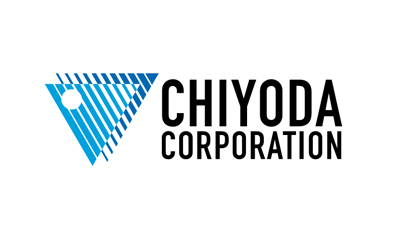
Challenge
- As a way of addressing diversifying customer needs in an era defined by change, Chiyoda needed to engage in the development of personnel who can perform business co-creation with the aim of expanding the ranks of personnel core to engineering, procurement and construction (EPC) and transforming the company towards a future business portfolio.
- In assigning people to projects where development is needed, in addition to awareness and knowledge on the part of the assignment manager, it is necessary to make high-impact assignments by mutually matching people based on each employee’s aptitude and capacity for executing operations.
- In businesses that have significant amounts of highly specialized work, it is necessary for employees to be able to visualize the opportunities they can get at the company beyond the domain they are personally responsible for and the career paths they can thus chart, and to be able to autonomously and flexibly form their own careers.
ABeam Solution
- ABeam co-created designs for operations and systems that grasp the business as a whole through proactive discussions with related departments such as HR, IT, and various on-the-ground departments. We worked side-by-side with the client to build operations leveraging talent management that “offers value to everyone.”
- We clarified use cases for operations in terms of “what conditions to use to look for people when assigning them,” considered the granularity and details of data that would be easy to use for this, and, furthermore, considered the structure of such data, taking into account extensibility.
- We broadly incorporated cutting-edge technology such as low-code development platforms and the use of AI, and proposed methods for realizing the development of personnel while checking the operation of such systems.
Success Factors
- We ascertained needs for talent management as seen from a variety of perspectives including the viewpoint of personnel management from the corporate side and the viewpoint of talent utilization on the ground in projects, and formulated optimal work concepts and systems requirements.
- By structuring experience and career histories, which had been unstructured data, as “project area x factor engineering x position,” we turned this information into data and established usable foundations.
- By promoting information management of career aspirations, target setting, evaluation information and other information through talent management systems and thus being able to grasp personnel information through data when needed for whom it is needed, we realized talent management that works closely with each individual employee. This provided functionality that can present each individual employee with customized “future possibilities” by not only reflecting on their past and checking their current position, but also by enabling analysis of the experience information of other employees.
Client Challenges
Creating a personnel cycle that can respond to changes in the business environment by assigning employees in a way that aligns the business with the career aspirations of each individual employee
ABeam Consulting has been providing support to Chiyoda Corporation since its implementation of SAP in 2012. Having highly rated ABeam Consulting’s end-to-end support from planning to execution and our ability to make compelling proposals, Chiyoda Corporation commissioned us to begin supporting its promotion of talent management, one of its key corporate DX measures, from December 2022. Chiyoda Corporation held discussions involving not only corporate departments but also people on the ground, under the leadership of ABeam Consulting, then organized the challenges it was facing in talent management as follows.
1. Addressing the issue of the generation gap and of inter-generational succession
Chiyoda Corporation has a generation gap in its current personnel make up, and, in particular, as mid-level employees retire (generational hollowing out), it has had inadequate passing on of the know-how and specialist knowledge needed to operate the organization. If this state of affairs persists, it will create an impediment to the future functioning of the organization, and risks undermining the competitiveness of Chiyoda as a company. For this reason, the development of the next-generation of leaders and specialists has become a pressing task.
2. Securing and developing personnel suited to the business strategy
Chiyoda Corporation needs to expand EPC to new areas and establish a sustainable model of business in order to realize its business strategy. It was essential for the company to capture and develop personnel suited to business development in particular, in order to respond to fierce competition, necessitating the formulation of a plan for securing and developing appropriate talent.
3. Optimization and surfacing of deployments
At present, assignments to projects are often based on individual interpersonal relations and tacit knowledge, and progress has not been made on optimizing this company-wide. For this reason, there is room to improve in the direction of having assignments that contribute to deploying people in an optimal way across the entire company and to “autonomous careers” in which employees can head in the direction that they want to grow. This necessitates the creation of systems that enable the surfacing of personnel information and the assignment of people based on data. In addition, if employees are assigned to work for which they have relatively little motivation, proper talent management can visualize for them how they can make use of the experience and skills they gain through the assignment in their future careers at Chiyoda Corporation. Employees can thereby be given the chance to notice career paths that they themselves might not have been able to imagine, with the company thus seeking to improve their motivation.
4. Creating an environment in which employees and the company can work together to foster careers
In a business environment in which diverse changes occur, there is a need for employees to be able to think through and grow their own careers autonomously. In this context, companies also need to understand the career aspirations of their employees and provide them with suitable opportunities for growth while maintaining dialogue. There is also a need for companies to prepare environments in which employees can, in thinking about their careers, understand that there are expansive opportunities for them within the company and thus foster “flexible mindsets” that let them excel in diverse fields, and thereby become able to realize their ideal career paths.
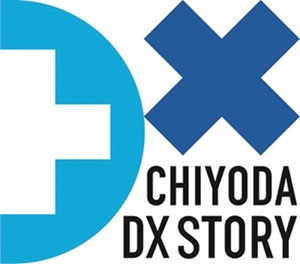
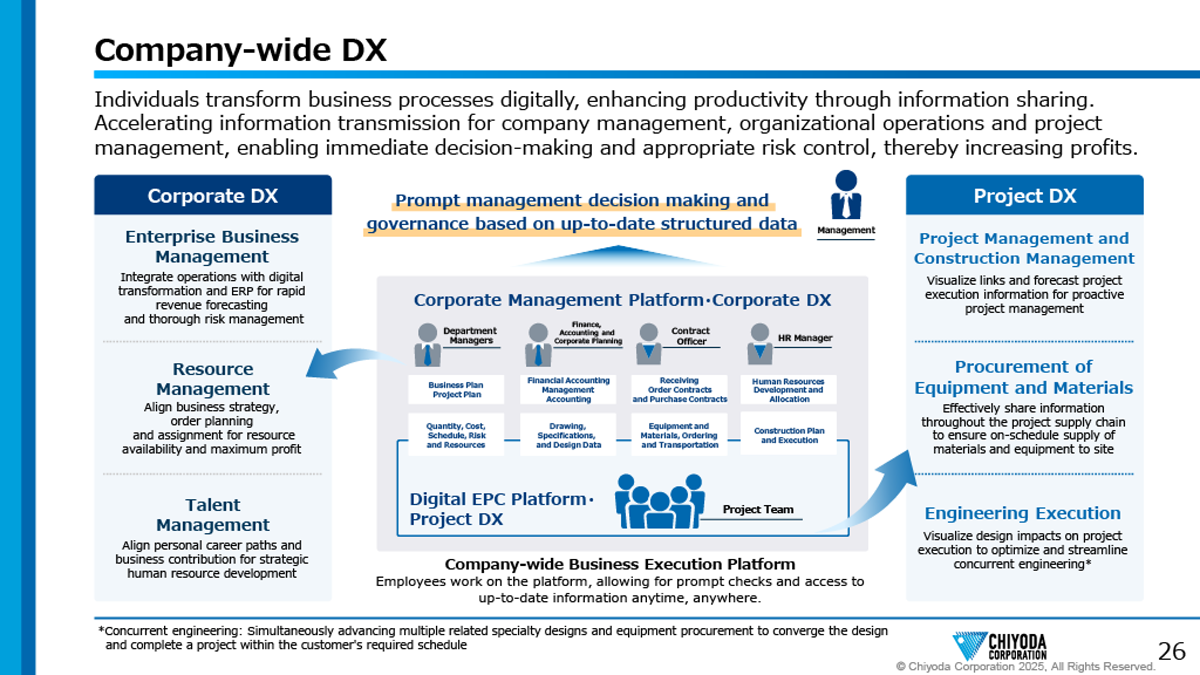
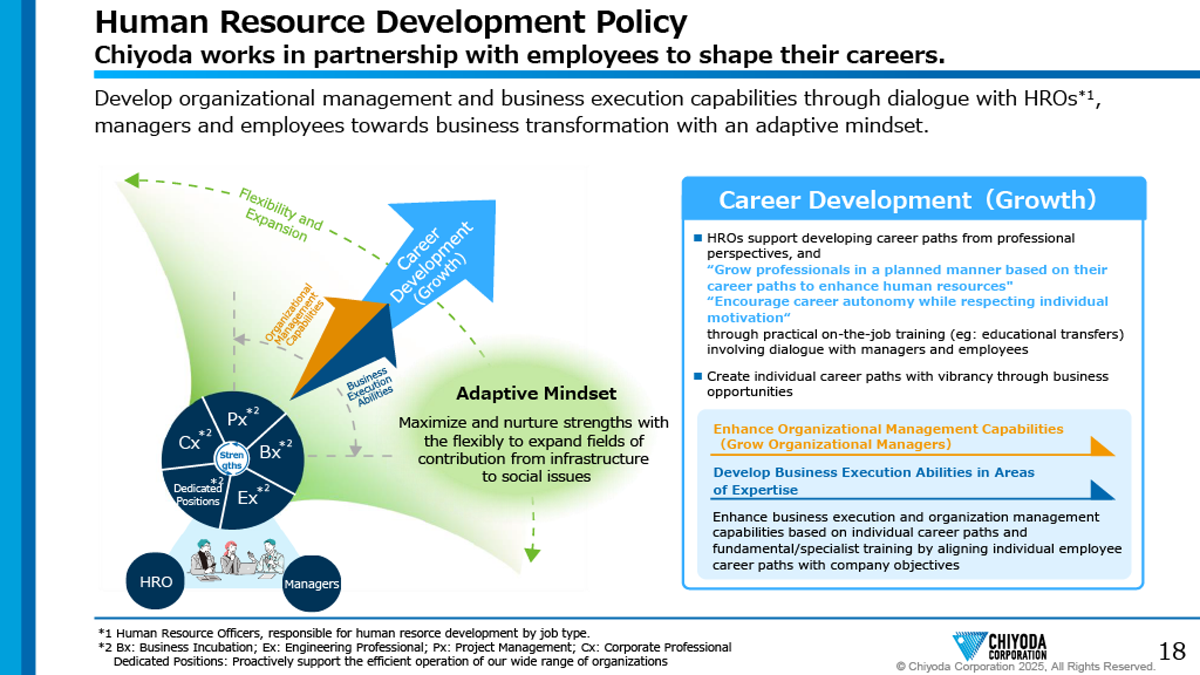 Medium-term management plan materials (Source: Chiyoda Corporation)
Medium-term management plan materials (Source: Chiyoda Corporation)
Key Project Success Factors
Connecting past experience to the present and tracing a trajectory to the future to generate day-to-day motivation
In planning and thinking through management operations, we focused on making it so that each employee could find for themselves a place to excel in developing their career, and paid attention to the question of how to get employees to think about that by using the power of digital technology to those ends. Focusing not just on the needs of the business, we also put the focus on the employees and made it a target to have them get a direct sense of “being able to see their efforts (careers),” “the sort of past they have had contributing to their present,” and “the expansiveness of the possibilities open to them in their future careers.” We aimed to realize value through the following three points in particular as focus items.
-
Storing each individual employee’s career as digital data
-
Focusing on work experience rather than skills as a source of information on “what this person can do.” Data management is performed using a structure of the form of factor engineering x position x project area.
-
Aggregating data and sharing it among employees. Simplifying and visualizing data using profiles such that users can see at a glance, for example, “what sorts of things can that person do.”
-
At present, the details of what is stored as data have expanded to the point of including career aspirations, interview outcomes, target setting and evaluations thereof. By making use of this data, going forward, it is expected that companies will be able to go further and propose career possibilities to employees.
-
-
Being able to make use of internal personnel information
-
Being able to search for personnel not only based on employee career history and qualifications, but also based on aggregated experience and career aspirations, thus helping assign the right people to the right roles.
-
Integrating long-term career aspirations, short-term target management and experience to date, and putting this into a form that superiors can understand contributes to providing employees with a high-satisfaction environment in the execution of their duties.
-
-
Showing future information
-
By aggregating and analyzing employee career history data, visualizing the sorts of future possibilities open to employees after a certain number of years, taking their current career as a starting point.
-
By using the system to demonstrate the excitement of considering the various options open to them in their careers, the system aims to improve motivation for the future, while also clearly showing the positions or steps towards their aspirations that employees need to follow.
-
We adopted an approach in which we advanced the implementation of the talent management system by finely separating functions and checking the functioning of the system throughout development, while working to reduce the gap between the vision and reality, and adding changes needed to improve it. The project team itself also developing while releasing new features in stages and the quality of considerations thus improving was another factor behind the success of the project. Due to the expansion of types of viewable talent data and data utilization work, the potential of talent management-enabled operations has swelled and is continuing to grow.
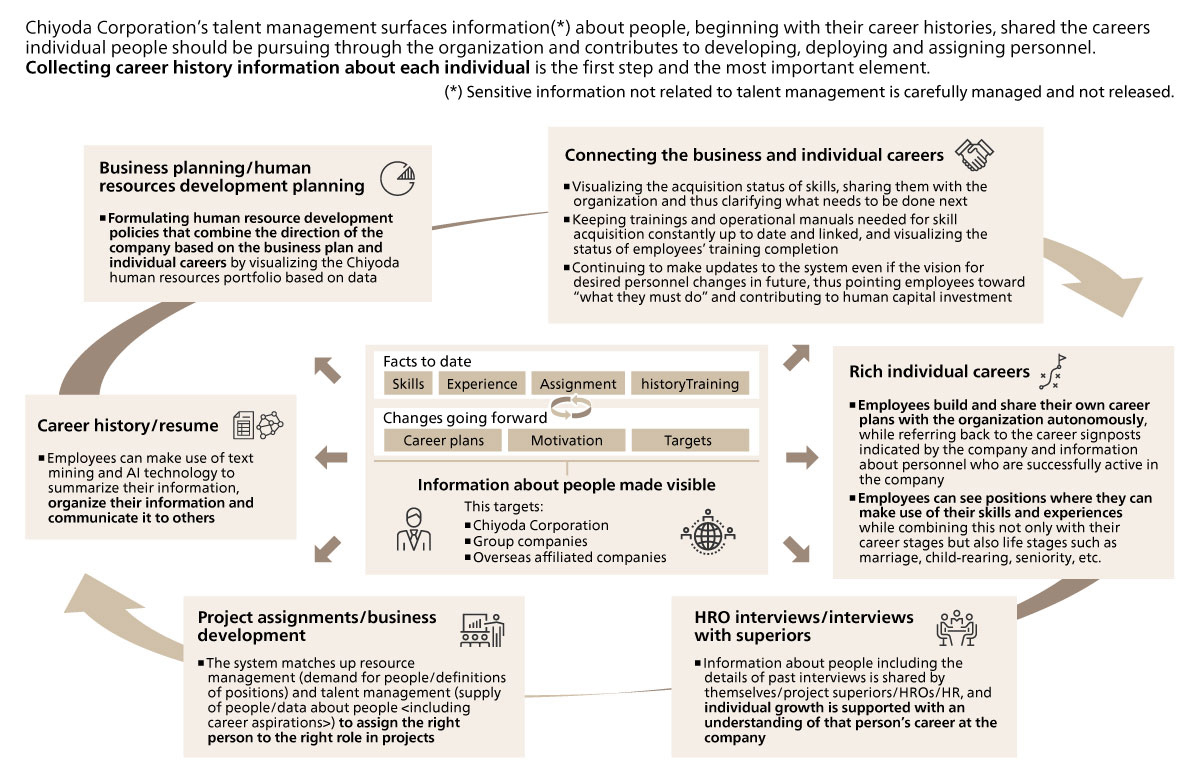 Overview of talent management
Overview of talent management
ABeam’s Contribution
ABeam Consulting’s flexible transformation support moving forward together with the client
ABeam Consulting provided end-to-end support for everything from planning to execution and operations. By providing support for all processes, ABeam was able to consider everything up to systematization in line with operational objectives or flexibly course-correct, even if there were changes to the initial direction or unexpected requirements came up. This allowed us to drive the realization of value for users. In addition, we contributed to the implementation of talent management that can be utilized by all employees by working side by side with the company to make improvements and drive further upgrades to usability, taking into account the data utilization, status and operating status of the system, even after it was launched. Furthermore, by making use of our unique framework, leveraging our experience in building large-scale core systems using a low-code platform (OutSystems), which serves as our implementation architecture, we managed to implement talent empowerment that cannot be achieved using generic packages, and that goes beyond the bounds of traditional talent management, while limiting the implementation period.
To understand where the company is aiming to be and think through how to realize that in its digital technology aspects, while also being aware of the operations that would be needed to achieve those goals, required perspectives coming from multiple angles. By working closely with the client and examining and thinking through issues together, ABeam formulated a general direction that sought to maximize “individual activity,” which is being focused on as the current project. Standout among those efforts were the following contributions.
- ABeam proactively engaged on-the-ground departments at the front lines of talent utilization in discussions and devised a vision for talent management together with key people in talent management at each department. We gained an understanding of the characteristics and key points of operations across headquarters and each department and incorporated talent utilization perspectives that could be directly tied to business applications.
- We formulated an execution plan that not only sketched out an ideal case of “what we should do in making use of cutting-edge technology?,” but also struck an overall balance that was conscious of operating burdens and cost aspects, took practical solutions into consideration and thought through problems together with others, in a context of there being no single right answers and diverse perspectives.
In terms of future outlook, we aspire to be able to centrally manage all remaining elements that make up talent, including skills and competencies, on this platform. In doing so, we are also looking at making proactive use of AI technology and using it to maintain the freshness of data through automatic data gathering. Going forward, by deploying the system to group companies, we also hope to achieve broader and more flexible assignments and more dynamic personnel deployments. We also hope to expand opportunities for employees to excel and to build schemes that help them want to express themselves in their careers through better visualization. We also aim to build future-ready talent management operations in which the company and its employees can engage in a lively back and forth.
I want people working at Chiyoda Corporation to be able to be engaged with pride and passion for what they do. That is the place from where this project started. To that end, ABeam supported us from the conceptualization phase, organizing the project in a way that clarified for employees “what they had done and what they could (want to) do going forward,” and treated career autonomy as key. We held discussions with ABeam Consulting team members with the expectation that we could make use of the personnel information possessed by our company to make this an initiative aimed not at talent management but talent empowerment. While doing so, we managed to implement this approach and build the system. ABeam also involved all departments in executing the development process, contributing to the building of a system that involved the whole of the company.
HR & Corporate Affairs Division, Human Resources Department, Human Resources Development Section
Section Leader
Norimitsu Yanagimachi
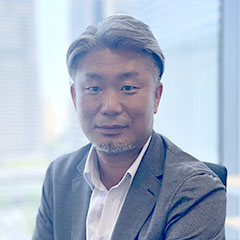
Customer Profile
- Company name
- Chiyoda Corporation
- HQ Location
- Minatomirai Grand Central Tower 4-6-2, Minatomirai, Nishi-ku, Yokohama 220-8765, Japan
- Estd.
- January 20, 1948
- Business
- Integrated engineering business including consulting, planning, engineering, procurement, construction, commissioning and maintenance for facilities related to gas, electricity, petroleum, petrochemical, chemical, pharmaceutical, antipollution, environment, preservation, and other services. Exploration of oil, gas and other mineral resources, and investment and financing to such exploration activities
- Capital stock
- 15,014 Million Yen

Oct 23, 2025
-
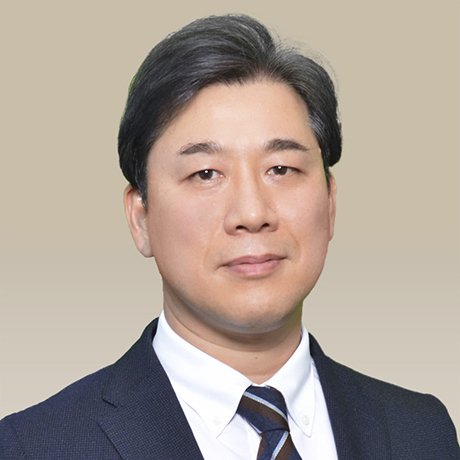
Takashi Sakamoto
Principal -
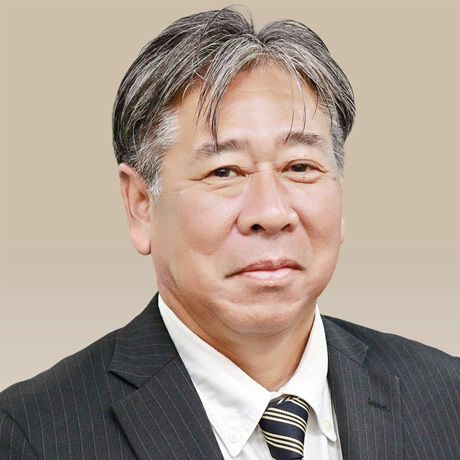
Nobuaki Suzuki
Director
Click here for inquiries and consultations
